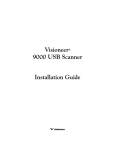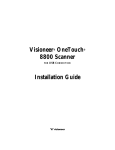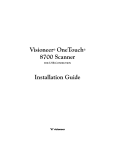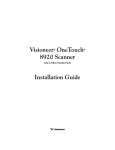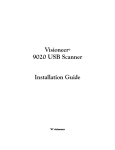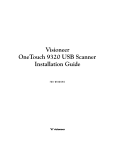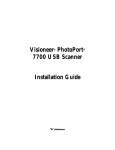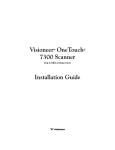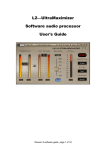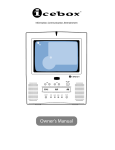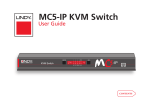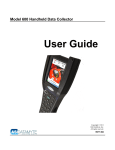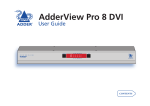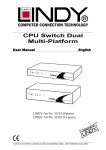Download Xerox 2400 Scanner User Manual
Transcript
05-0580-000 August, 2003 4800/2400 Series Installation and user guide ©Copyright 2003 by Visioneer. All Rights Reserved. Copyright protection claimed includes all forms and matters of copyrighted material and information now allowed by statutory or judicial law or hereinafter granted, including without limitation, material generated from the software programs that are displayed on the screen such as styles, templates, icons, screen displays, looks, etc. “Xerox® and the digital X® are trademarks of XEROX, used under license from Xerox Corporation.” Other company brands and product names may be trademarks or registered trademarks of the respective companies and are also acknowledged. Printed in the U.S.A. Table of Contents 1 Getting started with your new scanner Step 1: Installing the scanner software . . . . . . . . . . . . . . . . . . . . . . . . . . . . . . . . . . . . .1-1 Step 2: Connecting the scanner . . . . . . . . . . . . . . . . . . . . . . . . . . . . . . . . . . . . . . . . . .1-2 Getting the PaperPort software user’s guide . . . . . . . . . . . . . . . . . . . . . . . . . .1-4 Step 3: Checking out your scanner . . . . . . . . . . . . . . . . . . . . . . . . . . . . . . . . . . . . . . . .1-4 If the scanner is not properly connected . . . . . . . . . . . . . . . . . . . . . . . . . . . . . .1-5 2 Three ways to scan Scanning by pressing the One Touch buttons . . . . . . . . . . . . . . . . . . . . . . . . . . . . . . .2-1 About the One Touch buttons . . . . . . . . . . . . . . . . . . . . . . . . . . . . . . . . . . . . . .2-2 Scanning from the button panel on the screen . . . . . . . . . . . . . . . . . . . . . . . . . . . . . . .2-3 About the Configuration dialog box . . . . . . . . . . . . . . . . . . . . . . . . . . . . . . . . . .2-4 Selecting new options for the buttons . . . . . . . . . . . . . . . . . . . . . . . . . . . . . . . .2-6 Creating new configurations . . . . . . . . . . . . . . . . . . . . . . . . . . . . . . . . . . . . . . .2-7 Adjusting scan settings and page settings . . . . . . . . . . . . . . . . . . . . . . . . . . . .2-7 Setting preferences . . . . . . . . . . . . . . . . . . . . . . . . . . . . . . . . . . . . . . . . . . . . .2-10 Scanning from the PaperPort software . . . . . . . . . . . . . . . . . . . . . . . . . . . . . . . . . . . .2-13 Using TWAIN and Scan Manager Pro . . . . . . . . . . . . . . . . . . . . . . . . . . . . . . .2-13 Adjusting the settings on the Scan Manager Pro . . . . . . . . . . . . . . . . . . . . . .2-17 Scanning 35mm slides and negatives . . . . . . . . . . . . . . . . . . . . . . . . . . . . . . .2-27 3 Troubleshooting and maintenance Installation troubleshooting . . . . . . . . . . . . . . . . . . . . . . . . . . . . . . . . . . . . . . . . . . . . . .3-1 Cleaning the scanner glass . . . . . . . . . . . . . . . . . . . . . . . . . . . . . . . . . . . . . . . . . . . . . .3-1 How to uninstall your scanner . . . . . . . . . . . . . . . . . . . . . . . . . . . . . . . . . . . . . . . . . . . .3-2 Step 1: Uninstalling the One Touch software . . . . . . . . . . . . . . . . . . . . . . . . . .3-2 Step 2: Uninstalling the PaperPort software . . . . . . . . . . . . . . . . . . . . . . . . . . .3-4 Contacting technical support . . . . . . . . . . . . . . . . . . . . . . . . . . . . . . . . . . . . . . . . . . . . .3-5 4800/2400 Series Installation and User Guide iii iv 4800/2400 Series Installation and User Guide 1 Getting started with your new scanner Congratulations on purchasing your One Touch scanner. With your scanner, you can quickly scan paper documents and color photos to place their electronic images on your computer. If you have a transparency adaptor with your scanner, you will also be able to scan 35mm negatives and slides. Step 1: Installing the scanner software NOTE: You must install the scanner software before connecting the scanner to your computer. Otherwise, the correct driver software for your scanner will not be installed and it may not work properly. To install the scanner software: 1. Start your computer and make sure that no other applications are running. 2. Insert the CD into your computer’s CD-ROM drive. The CD automatically starts. Figure 1-1 Insert CD NOTE: If the CD does not automatically start, make sure the CD drive’s door is completely shut. If the CD still does not start, click the Windows icon named My Computer. The window shows the drives available on your computer. Double-click the icon for your CD-ROM drive to see the list of files on the CD. Double-click the file named START32.EXE. The CD starts. 3. When the CD window appears, select the language in which you require installation instructions. Then click the [PaperPort] button, select the language you would like PaperPort to be 4800/2400 Series Installation and User Guide 1-1 Getting started with your new scanner installed in, and follow the instructions on the screen to install the scanner software on your computer. When you are finished installing the software, a message instructs you to connect the scanner to the computer. Figure 1-2 Connect scanner 4. Follow the steps in “Step 2: Connecting the scanner” to connect the scanner. When you’re finished, click [Finish] in the dialog box above. Step 2: Connecting the scanner The One Touch scanner connects to any available USB port. Check your computer’s manual for the USB port location. NOTE: You do not have to shut off the power to your computer when connecting the scanner to a USB port. To connect your One Touch scanner: 1. 1-2 Your scanner may have a locking tab. Turn the scanner over to see the locking tab on the bottom. Slide the locking tab to the unlocked position. 4800/2400 Series Installation and User Guide Getting started with your new scanner Unlocked position Figure 1-3 Unlock scanner NOTE: The locking tab protects the scanner’s scan head by holding it securely in position. Lock the scanner when transporting it from one location to another, but always remember to unlock it before scanning. The scanner will not scan when locked. 2. If your scanner does not have a Transparency Adaptor, go to Step 3. If your scanner has a Transparency Adaptor, check that the cable is plugged into the option port on the back of the scanner. Your scanner is shipped with the cable already plugged into the option port, however, if the cable came loose during shipping, you must plug it into the port securely. Figure 1-4 Plug in adaptor cable 3. If your USB cable is connected to the scanner, plug the USB cable on the back of your scanner into any USB port on your computer. If you USB cable is separate, plug one end of the cable into any USB port on your computer and plug the other end of the cable into the scanner’s USB port. Figure 1-5 Plug in the USB cable 4800/2400 Series Installation and User Guide 1-3 Getting started with your new scanner 4. Plug the power supply cable into the jack on the back of the scanner, then plug the power supply into a wall outlet. USB Cable Power supply Figure 1-6 Plug in power supply A progress message appears saying that the scanner has been found. The scanner is now correctly installed. NOTE: If you computer is running Windows XP, you may see messages about using a fast USB 2.0 connection for the scanner. If your computer is not equipped with USB 2.0 ports, you can just disregard those messages. 5. Click the [Finish] button. 6. From the CD, install the other software applications. 7. When you have finished installing the other software, remove the CD from your computer and store it in a safe place. Getting the PaperPort software user’s guide The Installation CD also includes your ScanSoft PaperPort User’s Guide. This guide provides more detailed information about the PaperPort software’s features. Please see the CD to view or print the guide. Step 3: Checking out your scanner The One Touch software adds the scanner icon to the Windows taskbar (at the bottom right corner of the computer screen). If the scanner is properly connected, the scanner icon looks like the one in this figure. Scanner Icon Figure 1-7 Scanner icon If the icon has a red X through it, the scanner is not properly connected. See the next section, “If the scanner is not properly connected,” for the steps to fix the problem. 1-4 4800/2400 Series Installation and User Guide Getting started with your new scanner To check the status of the scanner: 1. Right-click the scanner icon. The shortcut menu appears. Figure 1-8 Shortcut menu 2. Choose [About] from the shortcut menu. A dialog box confirms that the scanner is properly connected. Figure 1-9 Scanner information 3. Click [OK] to close the dialog box. Your scanner is ready to scan. If the scanner is not properly connected If the scanner icon on the Windows taskbar has a red “X” through it, the scanner is not properly connected. Figure 1-10 Scanner is not connected Check for one of these possible problems: • Is a cable loose or not plugged in securely? Inspect all cable connections. Make sure all the cables are plugged in securely. • Is the scanner’s locking tab in the locked position? Slide the locking tab to the unlocked position. If you tried to scan with the scanner locked, you must restart your computer after unlocking the scanner. • Did you restart the computer after installing the software? If you didn’t restart the computer, it may not have loaded all of the software files. Try restarting your computer. 4800/2400 Series Installation and User Guide 1-5 Getting started with your new scanner Please see the Readme file in the PaperPort directory on your computer’s hard drive. The Readme file contains additional information that may help you diagnose problems connecting the scanner. Also see “Installation troubleshooting” on page 3-1 of this guide for more information. NOTE: The scanning lamp under the scanner’s glass needs to warm up before you can scan. A status message lets you know when the lamp is ready. The lamp then remains ready so you don’t have to wait for it to warm up each time you want to scan. To conserve electricity and prolong the life of the scanner, you can set the length of time for the lamp to remain lit before powering down. See “Setting preferences” on page 2-10. To connect the scanner: 1. After checking for all the above problems, right-click the scanner icon with the red X over it. The shortcut menu appears. Figure 1-11 Reconnect the scanner 2. Choose [Connect] from the shortcut menu. The software finds the scanner and makes the connection. The scanner icon will no longer have a red X through it, and you are ready to begin scanning. If you try all the troubleshooting procedures described above, in the Readme file, and the “Installation troubleshooting” on page 3-1 and the scanner icon still has a red X through it, you may have a malfunctioning scanner. Please see “Contacting technical support” on page 3-5 for technical assistance telephone numbers. Also visit our web site at www.xeroxscanners.com for additional technical information. 1-6 4800/2400 Series Installation and User Guide 2 Three ways to scan You can scan paper items by pressing a One Touch button, by clicking a button on the screen, or from the PaperPort software (or other TWAIN software). Scan with the scanner buttons Press a button on the scanner’s front panel. Figure 2-1 Press a scanner button Scan from the screen Click the scanner icon on the Windows taskbar. A panel representing the scanner buttons appears. Click a button on the panel. Figure 2-2 Button panel Scan from the PaperPort software (or other TWAIN software) Start the PaperPort software, click the [Scan] icon on the PaperPort command bar, and then click the [Scan] button on the Scan pane. You can also scan from other TWAIN software. Scanning by pressing the One Touch buttons Pressing a scanner button scans the item, and then sends the image either to the printer, or to a software application—called the destination application—on your computer. To scan by pressing a button on the scanner: 4800/2400 Series Installation and User Guide 2-1 Three ways to scan 1. Place an item to scan on the glass, face down, and align the edge of the item with the arrow marker at the lower left corner of the glass. 2. Close the lid and press one of the scanner buttons. The scanner starts scanning the item. Messages just above the Windows taskbar shows the status of the scanning. During scanning, the scan progress window shows a small copy of the image, as illustrated by this example: Figure 2-3 Scan progress and image in PaperPort When the scan is complete, the scanned image appears in the destination software. In this example, the destination software is the PaperPort Desktop. About the One Touch buttons The One Touch buttons are preconfigured for typical scanning tasks. To change the settings for the buttons, see “About the Configuration dialog box” on page 2-4. Figure 2-4 Scanner buttons The following table lists the scanner’s preconfigured settings: Button 2-2 Function Preconfigured Settings Scan Scans the item as a color page and displays in in PaperPort. Email Scans the item as a color photo and attaches it to a new email message in your email application. OCR Converts the item’s text to black and white word processing text, and displays it in a word processing application. 4800/2400 Series Installation and User Guide Three ways to scan Button Function Preconfigured Settings Copy/ Print Prints the scanned item in black and white on your printer/copier at the printer/copier’s default resolution. Custom Scans the item as a color photo and displays it in an image processing application. NOTE: If a button is not preconfigured, the Configuration dialog box appears when you press that button so you can configure it manually. For example, if your computer does not have email software installed, the Email button cannot be configured. Scanning from the button panel on the screen Scanning from the button panel on the screen is just like pressing a scanner button, except you click the button on the screen. The scanner scans the item, and then sends the image either to the printer, or to a destination application on your computer. This method of scanning is especially helpful if the scanner is not located close to your computer. To scan from the screen: 1. Place an item to scan on the glass, face down, close the lid, and then click the scanner icon on the Windows taskbar. The scanner button panel appears on the screen. Figure 2-5 Button panel 2. Click the button you want to use to scan. The scanner starts scanning the item; the messages about the scanning appear above the Windows taskbar; the progress window shows the image as it is scanned. When the scan is complete, the scanned image appears in the destination application. The icons on the buttons indicate the destination application for the scanned image. For example, in the illustration above, the icon on the email button is for the email application, MS Outlook. When you click the email button, the item is scanned, and then MS Outlook opens. In this case, the scanned image automatically becomes an attachment to send with an email message. 4800/2400 Series Installation and User Guide 2-3 Three ways to scan A question mark icon on a button means your computer does not have an application that corresponds to that button’s functions. For example, if your computer does not have an email application, the Email button will have a question mark icon on it. About the Configuration dialog box The Configuration dialog box shows the current settings for each scanner button. The tabs across the top of the dialog box correspond to the buttons. Clicking a tab shows the current settings for the corresponding button on the scanner. For example, the following figure shows the current settings for the Custom button because the Custom tab is selected. The Custom button is set up to scan the item with the configuration named Photograph for Editing, and then after the scanning is finished, to open Microsoft Paint to display the scanned image. The Format and Page(s) setting is to scan as a bitmap for a single page item. Click this tab to set preferences Click the tab that corresponds to the scanner button you want to configure. Select a setting for scanning the item. Select a software application to send the scanned image to that application. Select format and page(s) options for the button. Figure 2-6 Configuration dialog box See “Setting preferences” on page 2-10 to set Preferences. To display the Configuration dialog box: 1. Right-click the scanner icon. Scanner icon Figure 2-7 Scanner icon The shortcut menu appears. 2-4 4800/2400 Series Installation and User Guide Three ways to scan Figure 2-8 Shortcut menu 2. Choose [Configure] from the shortcut menu. The Configuration dialog box appears. The options on the Configuration dialog box are: Select Destination – the list of applications that can open to display the scanned image. Select the application that you want to automatically open to display or process the scanned image. Select Configuration – the list of the button’s scan configurations. The configuration settings include: color, black and white, or grayscale, resolution in dots per inch (dpi), page size, brightness, and contrast. To see the details about a configuration, click its icon in the list. Click the icon again to close the detailed information. Clicking an icon expands the configuration to show its settings. Figure 2-9 Select Configuration list Select Format and Page(s) – a set of options for selecting a format for the scanned image and whether to scan a single page or multiple pages. The formats are bitmap and PaperPort. Use PaperPort for scanning any item. Bitmaps are usually for photos or artwork. The page icons represent single or multiple page scanning. Scan single page Scan multiple pages Scan multiple pages and stack them on the PaperPort Desktop Figure 2-10 Format and page options 4800/2400 Series Installation and User Guide 2-5 Three ways to scan Options – displays a dialog box for selecting options about the destination application for the scanned image. Each destination application has its own options dialog box. Folder Copy – displays a dialog box for selecting the folder to use for storing copies of the scanned images. Getting Help You can get help with the scanner’s features or any of the options on the Configuration dialog box using either of the following methods: • When the Configuration dialog box is displayed, press the [F1] key on your keyboard. • Click the [Help] button at the top right corner of the Configuration dialog box. Help button Figure 2-11 Configuration dialog help button Selecting new options for the buttons You can select a new destination application, configuration, and image format for a scanner button to optimize it for the type of scanning you want to do. You use the Configuration dialog box to select new options. To select new options for a scanner button: 1. Press and hold down the button that you want to change. The Configuration dialog box appears. The tab of the button whose options you want to change is already selected. If the tab is not selected, click it. You can also right-click the scanner icon in the Windows taskbar to see the shortcut menu, and then choose [Configure] to display the Configuration dialog box. 2. Scroll the list of applications in the Select Destination list and click the new application you want to use to view and work with the scanned image. NOTE: If you select a word processing program such as Microsoft Word and a configuration for OCR, the text in scanned images is automatically converted to editable text by the optical character recognition (OCR) software that you receive with the scanner. The converted text then appears in the selected destination application. 2-6 4800/2400 Series Installation and User Guide Three ways to scan 3. Click a selection in the Select Configuration list to choose a new scan configuration for the selected scanner button. The configurations are preset for the application you select in the application list. If you select another application, the configurations are for that application. If you want to select a configuration prior to scanning, click the option, [Configure before Scan]. When you press a scanner button, the Scan Manager Pro dialog box appears first and you can select a configuration before scanning. See “Using TWAIN and Scan Manager Pro” on page 2-13. 4. Select one of the Format and Page(s) options for the button. 5. Click [OK]. Now when you press the scanner button, it scans the image using the new configuration settings and displays the scanned image in the new destination application. NOTE: The Configuration dialog box is also available from the scanner icon on the Windows taskbar. Click the icon to see the scanner buttons panel. Click a button on the panel with the right mouse button. (Don’t click with the left mouse button because clicking with the left mouse button starts scanning.) The Configuration dialog box appears. Creating new configurations You cannot change settings such as brightness or contrast of the preset configurations. To scan with settings other than those offered by the preset configurations, you must first create a new configuration. To create a new configuration click the [New] button. You can also click [Copy] to copy a preset configuration, change its settings, and then save it under a new configuration name. Adjusting scan settings and page settings When scanning using a configuration that you created yourself, you can adjust that configuration’s scan settings and page settings. For example, if the scanned image is too dark, you can adjust the brightness of the scan setting. NOTE: You cannot change the scan settings or page settings for any of the predefined scan configurations. You can only adjust for scan configuration that you create yourself. See the section above, "Creating New Configurations". To adjust the scan settings and page settings: 1. Display the Configuration dialog box. 4800/2400 Series Installation and User Guide 2-7 Three ways to scan 2. Click the tab of the button whose options you want to change. 3. In the Select Configuration list, click the configuration that you want to adjust. For example, the following figure shows a configuration named Special Scan for Dark Print (which you would have created earlier). Figure 2-12 Edit a configuration 4. Click the [Edit] button. The dialog box appears for adjusting the scanning settings of the selected configuration. Figure 2-13 Edit scan settings 5. Adjust the scan settings that you want. Mode – Select Black/White to scan in black and white. For example, letters and memos are usually scanned in black and white. Select Grayscale to scan items such as documents containing drawings or black and white photographs. The 2-8 4800/2400 Series Installation and User Guide Three ways to scan scanning produces an image in varying shades of gray. Select Color to scan color photographs and other color items. Resolution – Drag the slider to the right or left to adjust the dots per inch (dpi) of the resolution. The higher the dpi setting, the sharper and clearer the scanned image. However, higher dpi settings take longer to scan and produce larger files for the scanned images. Brightness and Contrast – Drag the sliders to the right or left to adjust the brightness and contrast of the scanned image. The Contrast setting does not apply to the Black/White mode. 6. Click the [Page Settings] tab to adjust the scan page settings. Figure 2-14 Edit page settings Page Size – Choose a page size from the drop-down list. The outlines on the picture represent the various page sizes. Clicking one of those outlines also selects it as the page size for the scan. If you select the Custom option from the dropdown list, boxes appear in place of the picture. Enter the horizontal and vertical page dimensions in the boxes. AutoCrop – Select this option to let the scanner automatically determine the size of the item being scanned. For example, if you put a photo in the middle of the glass, the scanner will automatically determine the size of the photo. When AutoCrop is selected, the scanner makes two passes—the first pass senses the item’s size, and the second pass scans the image. This option overrides the Page Size menu selection. DeScreen – Select this option when scanning a picture from a newspaper or magazine article, or other item that contains images with patterns or dots. Scans of patterns or dots sometimes have a distorted or wavy appearance. The scanner scans the item to compensate for the patterns and dots, and produces a clearer image. The scanning may slow down a bit when this option is selected. You do not need to select this option when scanning photographs. The DeScreen setting does not apply to the Black/White mode. 4800/2400 Series Installation and User Guide 2-9 Three ways to scan Gamma – Drag the slider to improve how the colors in a scanned image look on your monitor. Gamma correction allows you to achieve precise color matching. Because the computer cannot always transmit the exact color information to the hardware, you may have to make some color adjustments using the Gamma feature. The default Gamma setting works fine in most cases and normally does not need to be adjusted. 7. Click [OK]. The Configuration dialog box reappears. Make sure the configuration you just defined is selected. 8. Click [OK] on the Configuration dialog box. The new configuration and its adjusted settings now apply to the button whose tab is selected at the top of the Configuration dialog box. NOTE: If you select the Copy/Print button, the dialog box for editing and adjusting the settings will have a Device tab for selecting options for a printer or copier. See the Help for more information. Setting preferences The preferences apply to each button and to the scanner. To set preferences: 1. On the Configuration dialog box, select the tab for a button to set its preferences. 2. Click the [Preferences] tab on the Configuration dialog box. Preferences tab Figure 2-15 Preferences tab The Preferences dialog box appears. The dialog box shows which button you selected for new preferences. 2-10 4800/2400 Series Installation and User Guide Three ways to scan The name of the button to receive new preferences Figure 2-16 Button preferences 3. If the Button tab on the Preferences dialog box is not selected, click it. Show All Destinations – Clicking this option automatically selects all the destination applications categories. When you click the button’s tab on the Configuration dialog box, its list of destination applications include all of the applications on your computer that fall into these categories. For example, the destination applications for the email button are usually email applications. By selecting the Show All Destinations option as the preference for the email button, all the other types of applications are included in the list of email destination applications. Select Destinations – Select this option to individually choose the types of applications to include in the button’s list of destination applications. Click in the boxes for the types of applications to include in the button’s list. Show Scan Progress Window – Select this option to see the window that shows a rendition of the image during the scanning. 4. Click the [General] tab to set preferences for the scanner. 4800/2400 Series Installation and User Guide 2-11 Three ways to scan Figure 2-17 General preferences Show Status Window – Select this option to see the small window at the bottom right corner of the screen that shows the status of the scanning and other information as shown in this sample: Figure 2-18 Status window Show Scanner Icon in Windows Taskbar – Select this option to see the small icon representing the One Touch scanner in the Windows taskbar. Figure 2-19 Scanner icon Scanner Lamp turns off – These options control when the scanner lamp powers goes off. • After idling for xx minutes – Select this option to automatically turn off the lamp if the scanner hasn’t been used for the specified time. This option saves energy and extends the lamp’s life. Click in the box and enter the number of minutes for the lamp to remain idle before turning off. If you scan when the lamp is off, it warms up before scanning resumes. • On System Standby/Shutdown – Select this option to turn off the lamp when you turn off your computer, or when the computer’s energy saver option automatically puts the computer into standby mode. Folder for Temporary Images – Click the [Folder] button and then select a folder for the scanner’s temporary images. During scanning, a temporary file contains scan information about the image. Because temporary image files can sometimes be large, select a folder that has sufficient disk space available. 5. 2-12 Click [OK]. 4800/2400 Series Installation and User Guide Three ways to scan Scanning from the PaperPort software Instead of using a scanner button, you can scan directly from the PaperPort software. NOTE: You can also scan directly with other software that meets the TWAIN standards for scanning, which includes many graphics and imaging applications available for your computer. The following steps explain how to set up and scan from the PaperPort software but you can use the same basic processes with other TWAIN software. To scan from PaperPort, you must first do a one-time-only set up of the software. To set up the scanner: 1. If the PaperPort software isn’t currently running, double-click the PaperPort icon on the Windows Desktop to start it. The PaperPort Desktop appears. 2. From the [File] menu, choose [Scan]. Figure 2-20 Select scanning source 3. Choose [Xerox Scan Manager Pro]. NOTE: You don’t need to set up the scanner again unless you change the selected source to another TWAIN device, such as a digital camera. Using TWAIN and Scan Manager Pro The following steps explain how to scan an item using the TWAIN button in the PaperPort software. You can scan many types of paper items, from small business cards to A4-sized pages. NOTE: Your One Touch scanner is initially set to scan from the PaperPort software for color items. To scan a black-and-white or greyscale item, select one of the other configurations from the Scan Manager Pro’s list of configurations. To scan at a higher resolution for a color image, select Color—Better Quality. However, 4800/2400 Series Installation and User Guide 2-13 Three ways to scan scanning at a higher resolution creates a larger file size and takes longer to scan. To minimize the file size and the time required to get a better quality scan, select just the area of the item that you want to scan. To scan an item: 1. Open the scanner cover, place the item face down onto the lower left edge of the scanner glass, and close the cover. 2. If PaperPort isn’t running, double-click the PaperPort icon on the Windows Desktop to start it. The PaperPort Desktop appears. 3. Click the [Scan] icon on the PaperPort command bar and then click the [Scan] button in the Scan pane. NOTE: You can also scan from other applications that have the TWAIN capability. See the user’s guides that you received with those applications for their specific steps to scan. The Scan Manager Pro appears. Choose a scanning option. Scan Reflective Using is for scanning paper items. The other options are for transparencies. Click an icon to select a configuration—Color, Grey Scale, or Black&White. This example shows the Color/ Custom configuration is selected. Clicking the “+” sign in front of Custom shows Custom’s scan settings as a list. Click a setting in the list if you want to change it. The setting’s options appear on the right side of the Scan Manager Pro where you can select new options if necessary. Check the Scan Info to make sure your computer has sufficient space for the image. Warning icons on this box appear if your computer does not have enough space for the scanned image’s file. Click Preview to see what the image will look like. The Preview image appears in the window. If the image is what you want, click Scan. If not, adjust the settings or select a new configuration and click Preview again. Click AutoScan to scan with your preset scan choices. Figure 2-21 Scan Manager Pro 2-14 4800/2400 Series Installation and User Guide Three ways to scan You can now scan manually by previewing the image and adjusting the scan settings to your liking, or you can click [AutoScan]. The AutoScan feature uses your preset scan settings and the scanner’s automatic image analysis capabilities to find the optimum combination of settings for the item you’re scanning. NOTE: The appearance of the Scan Manager Pro window depends on your computer monitor’s screen resolution. Therefore, what you see on your computer screen may be slightly different than the examples shown in this guide. To scan manually: 1. On the Scan Manager Pro, select a configuration for the scan. For example, select Color Configurations and then select Custom to scan a color item with the preset Custom scan settings. That configuration’s settings appear as a list. Click the “+” (plus) sign to see the full list of scan settings. Click the “-” (minus) sign to collapse the list. To see the settings for another configuration, click it in the list. For example, to see the Grey Scale settings, click the Grey Scale configuration. 2. Click the [Preview] button to preview the scanned image before scanning it. The scanner scans the item and displays a preview using the options you selected. 3. Review the image to make sure it is what you want. 4. To adjust one of the settings for the scan, click it in the list of settings. A panel appears on the right side of the Scan Manager Pro for that setting. Select new options for the setting on that panel. See “Adjusting the settings on the Scan Manager Pro” on page 2-17 for more about changing the scan settings. 5. (optional) To preview the image again, click the [Preview] button. 6. Readjust the settings if necessary. 7. When you’re satisfied with the image settings, click the [Scan] button. When the scan is complete, the scanner displays the final image as a thumbnail on the PaperPort Desktop. If the item is scanned as a bitmap image, a small bitmap icon appears in the lower left corner of the thumbnail. 4800/2400 Series Installation and User Guide 2-15 Three ways to scan Thumbnail image Bitmap icon Figure 2-22 Thumbnail images in PaperPort To scan automatically: 1. Click [AutoScan]. The scanner uses your preselected resolution setting for the configuration you selected. See “Setting preferences” on page 2-10 to set the AutoScan settings. In addition, your One Touch scanner has built-in image analysis capabilities that find the optimum combination of settings for the item you’re scanning. When you click AutoScan, the scanner analyzes the image and adjusts the settings to produce the optimal scanned image. The following dialog box appears while the scan is in progress. Check marks indicate that phase of the process is finished. Figure 2-23 Scanning progress The autoscanned image appears as a thumbnail on the PaperPort Desktop. 2. Use the PaperPort software to work with the image. Please see the PaperPort Getting Started Guide and PaperPort User’s Guide on the CD for more information about using the PaperPort software. 2-16 4800/2400 Series Installation and User Guide Three ways to scan Getting help with the PaperPort software The PaperPort software includes a complete set of help topics that answer questions about each feature of the software. To see help information, press the [F1] key, or from the [Help] menu, choose [PaperPort Help Topics] to display the Help Topics window. HINT: Also see the technical support card included with your scanner. Adjusting the settings on the Scan Manager Pro You can adjust the scan settings on the Scan Manager Pro to produce the best possible image. To adjust a setting: 1. Click a setting in the list of settings, or click its corresponding button on the right side of the Scan Manager Pro. Resolution and Sharpness Brightness and Contrast Color (Gamma, Saturation, and Hue) Scan Size Figure 2-24 Adjust Scan Manager Pro settings NOTE: The list of scan settings for a configuration only apply to that type of configuration. For example, the Black&White configuration does not have a setting for adjusting the Color Hue. The following figure shows an example of the Scan Manager Pro if you click the Resolution setting in the list, or click the Resolution and Sharpen button. 4800/2400 Series Installation and User Guide 2-17 Three ways to scan Click to close the settings panel Figure 2-25 Resolution settings NOTE: The information in the scan settings list and the options that you select on the various settings panels are interactive. That is, as you change the settings on the panel, the numbers in the list on the left also change. Saving a new profile If you adjust the scan settings you can save them as a profile for later use. To save a new profile: 1. Select a configuration on the Scan Manager Pro, such as Color/Custom. 2. Adjust the settings that you want for later use. 3. Click [Save As]. The Save Profile dialog box appears. Figure 2-26 Save a new profile 2-18 4800/2400 Series Installation and User Guide Three ways to scan 4. Type a name for the new profile. 5. Select the options you want: • Store the custom output image size in this Profile – You can create a custom image size as part of the settings; if you adjusted the output image size for the selected configuration, that output image size is saved with this profile. See “Saving a custom size” on page 2-24 for more about a custom image size. • Save the custom Response Curve and store it in this profile – You can also create custom settings for the colors of a scanned image. Those color settings are called the Response Curve. Select this option to save the response curve settings with this profile. See “Adjusting gamma, saturation, and color hue” on page 2-21 for more about the response curve settings. 6. Click [OK]. Your new profile is now listed as one of the configurations. Select it when you want to reuse its settings. Adjusting the Resolution and Sharpness Resolution determines the amount of detail you can see in the scanned image. The resolution setting for the scan is in dots-perinch (dpi). The higher the resolution, the finer the details, however, higher dpi settings also produce larger files sizes. Usually the higher resolution settings are used for precision work, such as photographs or fine artwork. Sharpness determines the amount of blur in an image. Your scanner can sharpen an original blurred image by adjusting the blurry edges in sections of the image. The figure on the left shows the resolution and sharpen options. NOTE: The location of various button on the panels may be slightly different on your Scan Manager Pro window because the appearance of the window depends on your computer monitor’s screen resolution. To adjust the resolution and sharpness: 1. To use one of the preset resolutions for typical scanned items, click one of the options in the list. For example, to set the resolution for scanning a business card, select Business Card. That setting is preset to read small print on a typical business card. 2. To set the resolution manually, drag the Resolution slider to the left to decrease the resolution or to the right to increase it. 4800/2400 Series Installation and User Guide 2-19 Three ways to scan 3. To adjust the sharpness, drag the Fidelity slider to the left to decrease the sharpness or to the right to increase the sharpness. You can also type a number directly into the sharpness setting box, or click the up and down arrows next to the box to increase or decrease the setting. 4. To return the settings to their original amounts, click [Reset]. The resolution and sharpen panel also includes an advanced setting for Moire patterns. Moire patterns are wavy, rippled lines that sometimes appear on the scanned images of photographs or illustrations, particularly newspaper and magazine illustrations. To scan the image and limit or eliminate the amount of moire patterns, select the [Reduce Moire] option. Adjusting the brightness and contrast Sometimes an item is scanned with the brightness and contrast set to be too light or too dark. For example, a note written with a light pencil may need to be scanned darker to improve legibility. The histogram shows the amount of the image (that is, the number of pixels) at different brightness levels. From left to right, the histogram indicates dark to light. To see this visually, drag the Brightness slider back and forth and watch how the distribution of pixels changes to indicate a darker or lighter image. The figure on the left shows the brightness and contrast options. To adjust the brightness and contrast: 1. Drag the Brightness slider to the left to make the item darker or to the right to make the item lighter. You can also type a number directly into the brightness setting box, or click the up and down arrows next to the box to increase or decrease the setting. 2. Drag the Contrast slider to the left to decrease the contrast or to the right to increase the contrast. The Histogram represents the settings as you drag the sliders. For color scan configurations you can adjust the brightness and contrast using a single color, or all together, by choosing from the drop-down menu at the top of the Histogram. For example, if you select Red from the menu and drag the Brightness and Contrast sliders, you can see how the red component of the histogram changes. Note, however, that the Green and Blue components also change relative to those new brightness and contrast settings. 3. 2-20 Click the [Auto] button to have the scanner analyze the image and set the appropriate brightness and contrast. 4800/2400 Series Installation and User Guide Three ways to scan You can also adjust the brightness and contrast by sampling portions of the image in the preview window. The three Sampler buttons correspond to the Black, Mid tones, and White portions of an image. To use the Sampler buttons: 1. Click one of the buttons. The pointer automatically moves onto the image and becomes a sampler pointer. 2. Place the pointer on the portion of the image for that sample and click. For example, if you selected the Black sampler button, place the pointer on the blackest part of the image. 3. Repeat with each of the other Sampler buttons. 4. Click [Adjust]. The image changes to show your new settings. 5. If the image is not what you want, click [Reset] to return the image to its original brightness and contrast. Adjusting gamma, saturation, and color hue If you’re using the Color Configuration to scan, you can adjust a group of color settings. Gamma controls the brightness of the midtones of the color, saturation is the strength or purity of a color, and hue is the color your eyes see as reflected from the image. These color settings are represented by a response curve. The horizontal axis of the response curve represents the original settings of the image, and the vertical axis represents new settings. Thus, the curve is a straight line from the lower left to upper right for an original, unchanged image. To see how the response curve indicates changes, drag the Gamma slider to left and right. The figure on the left shows the color options. To adjust the color settings: 1. From the Channel drop-down menu, choose the individual color (Red, Green, or Blue) that you want to use as the basis for adjusting the image, or choose [All] to adjust them together. 2. From the Edit Style drop-down menu, choose the type of color editing that you want to use: • Gamma – The response curve changes as you change the gamma setting; you can also change the saturation and hue settings. • Freestyle – You can drag points and sections of the response curve to create interesting and unusual color effects. Put the pointer on the curve and drag left, right, up or down. The image changes its colors in response to the 4800/2400 Series Installation and User Guide 2-21 Three ways to scan new curve. The x and y numbers at the bottom of the response curve indicate the exact position of the pointer on the curve. The Gamma slider remains fixed when you use the Freestyle option. 3. Drag the Gamma, Saturation, and Color Hue sliders to the left to decrease the settings or to the right to increase the settings. You can also type a number directly into the setting boxes, or click the up and down arrows next to the boxes. 4. Click [Reset] to return the settings to their original numbers. The upper Reset button is for the gamma setting, the lower one is for saturation and hue. 5. To save the settings of a response curve, click [Save]. Saving is available for settings created with the Freestyle editing option so you can load and reuse the exact settings on other images. This is especially helpful for complex Freestyle response curves. A dialog box appears that lists the names of previously saved settings. Type a name for your new settings and click [OK]. 6. To reuse a saved response curve setting, click [Load]. A dialog box lists the names of your previously saved settings. Select the one you want and click [OK]. Adjusting output size The item you’re scanning may not fill the scanner glass. In that case you can preview the item and use the Auto Trim option to automatically eliminate the unwanted sections of the image. You can also adjust the output size to scan only specific sections of an image. For example, if you’re scanning a photograph and want to focus on one section, adjusting the output size removes the rest of the photograph from the final scanned image. The figure on the left shows the output size options. To Auto Trim an item: 1. Click [Auto Trim]. 2. Click [Trim]. The scanner senses the edges of the item on the glass and draws a dotted line around the image in the window. Check to make sure the dotted line encloses the image that you want. A new Scan Info box on the lower left portion of the Scan Manager Pro shows the information for the autotrimmed area. 2-22 4800/2400 Series Installation and User Guide Three ways to scan 3. If the dotted line is not exactly where you want it, put the pointer on the line and drag the mouse. For example, if you want the scan to include a border around the image, you can drag the dotted line to be slightly larger than the autotrimmed area. To use the pointer to drag the line, make sure the pointer button is selected at the top of the window. 4. When the trimmed area is what you want, click [Scan]. To manually set the output size for an item: 1. To scan the entire item on the glass, click [Same as Original]. No sections are trimmed. 2. To set the output size yourself, click [Same as Original] to remove the checkmark. The settings for the output size become active. 3. Put the pointer on the image and drag the mouse to enclose the section you want in the scanned image. As you drag the mouse, a dotted box appears on the image and the size settings change to reflect the new output size area. You can also type in the size settings boxes. • Width and Height – The measurements of the final image after it’s scanned; for example, if you plan to print the image on a typical piece of paper, the width and height are 8.5 and 11.0 inches. • Units – Units of measurement for the new area; click the drop-down arrow and choose new units if you want. • Resolution – The dots-per-inch (dpi) setting for the new area. • Scale – The amount of enlargement or reduction of the image to fill the width and height measurements; for example, if you select a small area and have set the width and height to a paper size, the scale automatically increases to enlarge the small image so it’s the same size as the paper. A new Scan Info box on the lower left portion of the Scan Manager Pro shows the information for the new area. You can select multiple areas. A new Scan Info box appears for each one. The following figure shows an example of a manually selected area. NOTE: When you manually select an area, the settings on the other panels are for the selected area, not the whole image. For example, the histogram on the resolution panel and the response curve on the brightness and contrast panel refer to only your newly selected area. 4800/2400 Series Installation and User Guide 2-23 Three ways to scan A new Scan Info box for the area selected on the image. The area you selected to scan. Figure 2-27 Adjusting output size 4. If the dotted line is not exactly where you want it, put the pointer on the line and drag the mouse. To use the pointer to drag the line, make sure the pointer button is selected at the top of the window. 5. To rotate the selected area 90 degrees, click [Rotate 90 Degrees]. 6. To maintain the selected area’s length-to-width relationship (known as the aspect ratio), click [Maintain Aspect]. Note that as you rotate the area or maintain its aspect ratio, the width and height measurements change to reflect the new orientation of the image. 7. When the settings are what you want, click [Scan]. 8. If you want to remove the selected area and start over, click [Remove] on the Scan Info box. Saving a custom size If you have several items of the same size, such as a group of small photographs, you can create a custom size and reuse it whenever scanning those items. To save a custom size setting: 1. Click [Add] under the list of sizes. The Add Size dialog box appears. 2-24 4800/2400 Series Installation and User Guide Three ways to scan Figure 2-28 Save a custom size 2. Type a name and dimensions for the size. 3. Click [OK]. The new custom size is now listed in the box at the top of the panel. Select it in the list to automatically reuse the custom size. The Scan Info box The following figure shows the information on the Scan Info box: Physical size of the image to scan. Location of the top left corner of the image in the Preview window. Size of the file of the scanned image Current location of the pointer as you drag it on the Preview window. Amount of space on your computer’s hard drive. Figure 2-29 Scan Info box Zooming in and out You enlarge or reduce the preview image by zooming in or out. To enlarge and reduce the preview image: 1. Click the [Zoom] button. 2. Put the pointer on the image. 3. Click the left mouse button to zoom in (enlarge). 4. Click the right mouse button to zoom out (reduce). 5. To return the image to its full size, click the Pointer button directly above the Zoom button, put the pointer on the image and click the right mouse button. Select [Show Full Image] from the pop-up menu that appears. 4800/2400 Series Installation and User Guide 2-25 Three ways to scan Setting preferences You can set preferences for the Scan Manager Pro and scanner that are independent of the preferences for the PaperPort software. To set the Scan Manager Pro preferences: 1. Click the [Preferences] button. The User Preferences dialog box appears. Figure 2-30 Set user preferences 2. Select the preferences you want: • Enable selection of color bitdepths... – Your One Touch scanner supports a tremendous range of colors (defined as 48-bit depth enhanced color), but other devices (called the TWAIN clients), such as older cameras that you can use with the Scan Manager Pro support only a 24-bit depth range of colors. Select this option to automatically allow the Scan Manager Pro’s color settings to support more than a 24-bit depth if the other devices also support the greater range of colors. Then, when you open the Scan Manager Pro from other applications, options for bit depth include the higher settings. • Do not wait for the Lamp – When you first start scanning, the lamp in the scanner warms up slowly. This helps extend the life of the lamp. However, if you want the lamp to come on immediately without warming up. select this option. • Show standard metric paper sizes – Select this option if you use metric paper to print images. When you select the scan size output options, the width and height dimensions are then for metric paper sizes. • Show standard US paper sizes – Select this option to set the paper sizes for standard US paper. • Units – Select the measurement units for the ruler around the preview window. The x and y coordinates of the pointer position are relative to the units. 2-26 4800/2400 Series Installation and User Guide Three ways to scan • AutoScan Resolution – You can scan an item by clicking the AutoScan button on the Scan Manager Pro. The scanner uses these resolution settings for the respective configurations: Color, Grey Scale and Black and White. • Folder for Temporary Images – When you scan an item, its scanned image is initially stored in a folder before being sent to the PaperPort Desktop or some other application. Instead of using the default folder specified by the Scan Manager Pro, you can select another folder on your computer. Usually the only reason to select this option is if the default folder is on a hard disk with limited storage space. Click the folder icon and the Browse for Folder dialog box appears. Select the folder you want to use and click [OK]. That folder name is then listed on the Preferences dialog box. 3. Click [OK] to save your preferences. Getting help with the Scan Manager Pro To see the Scan Manager Pro help information, click the [Help] button. Scanning 35mm slides and negatives If your One Touch scanner has a Transparency Adaptor, it is specially designed to scan 35mm slides and negatives. You can scan both positive film and negative images. A brief explanation Your scanner has sensors that capture the image of the item being scanned. Those sensors are located in the body of the scanner. When you scan a paper item, the light in the bottom of the scanner shines up on the paper and reflects the paper’s image down onto the scanning sensors. If a 35mm slide or negative is on the glass, however, the light from the bottom of the scanner would shine up through the transparent 35mm slide or negative and would not reflect its image onto the sensors. That is why your scanner has a light in its document cover. When you scan a 35mm slide or negative, the light in the bottom of the scanner turns off, and the light in the cover shines down through the film onto the sensors to capture the film’s image. To position a 35mm slide or negative for scanning: 1. Find the appropriate mask for the item you’re scanning. The masks are in a protective plastic bag with your scanner. 4800/2400 Series Installation and User Guide 2-27 Three ways to scan P/N:180700002060 Mask for 35mm slides Mask for 35mm negatives Figure 2-31 Transparency masks 2. To scan a 35mm slide, first position the 35mm mask on the glass. The mask has one square corner. Align that corner with the arrow on the scanner body. Make sure that the text on the 35mm mask faces up so the slide fits properly in the mask. Follow the directions on the mask and place the 35mm slide horizontally into the slide holder. Calibration slot Figure 2-32 Slide placement Notice that the mask has a narrow slot above the 35mm slide holder. That slot is for calibration to assure that you get the best possible scan results. Do not place items to be scanned in the calibration slot. 3. To scan a negative, first slide the filmstrip into the 35mm negative mask and center the frame you want to scan in the opening. Then position that mask on the glass and align its square corner with the arrow on the scanner body. Make sure the text on the mask faces up. 2-28 4800/2400 Series Installation and User Guide Three ways to scan Figure 2-33 Negative placement The 35mm negative mask also has a calibration slot. Do not place items to be scanned in the calibration slot. You’re now ready to scan the slide or negative. To scan a 35mm slide or negative: 1. Start the PaperPort software, click the [Scan] icon on the PaperPort command bar, and then click the [Scan] button in the Scan pane. The Scan Manager Pro appears. HINT: You can also start the Scan Manager Pro from the scanner buttons by setting a button to "Configure Before Scanning". See “Configuration dialog help button” on page 2-6. 2. Click the drop-down menu at the top of the Scan Manager Pro and choose the type of transparency to scan. Scan 35mm Using: – Choose this option to scan 35mm slide positives. Scan Negative Using: – Choose this option to scan negative film or 35mm slide negatives. 4800/2400 Series Installation and User Guide 2-29 Three ways to scan Click the dropdown arrow and choose the transparency scanning option from this menu, The option “Scan Reflective Using” is for scanning paper items, not slides or negatives. Figure 2-34 Transparency scanning options 3. Click [Preview] to preview the image and, if necessary, adjust the various settings, then click [Scan] when the image is what you want. See “Using TWAIN and Scan Manager Pro” on page 2-13 for details about scanning. HINT: Set the resolution to 1200 dpi or better when scanning your slides and negatives. For steps to set the resolution, See the section, “Adjusting the Resolution and Sharpness” on page 2-19 for the steps to set the resolution. 4. When you are finished scanning, remove the masks from the scanner glass and store them in their protective bag. 5. Choose [Scan Reflective Using:] from the Scan Manager Pro’s drop-down menu to reset for scanning paper items. That setting turns off the transparency light in the document cover. 6. 2-30 If you adjusted the resolution and other settings for scanning slides or film, reset those settings for scanning paper items. 4800/2400 Series Installation and User Guide 3 Troubleshooting and maintenance Installation troubleshooting My computer isn’t recognising my scanner. I’ve checked the power and connections, what else should I check? Sometimes the driver does not install correctly and needs to be reinstalled (this occurs if the scanner is connected before the PaperPort software is installed). To check this go to the Control Panel and double click on the System icon. In the System Properties window, click on the Device Manager button or Hardware tab and then the Device Manager button (Win XP/2000). If your scanner is listed with an exclamation mark (!) next to it, delete this entry, restart your computer and the correct driver should be installed. During installation I got the error message: PaperPort Installation is not complete. What do I do? The installation procedure was not successful. You need to reinstall the PaperPort software. I got the error message: PaperPort cannot allocate enough memory to perform internal critical operations. What do I do? You should close any other active applications so that additional memory is available. If you click continue, PaperPort moves the file to the PaperPort data directory and renames the file with the prefix “bad.” This allows you to recover the file later. To recover the file, you can import it into PaperPort by using the Import command in the File menu. Cleaning the scanner glass Scanning items that have excessive amounts of dirt or dust may dirty the glass. To ensure the best quality scanned item, wipe the scanner glass with a soft clean cloth to rid the glass of dust or other debris. 4800/2400 Series Installation and User Guide 3-1 Troubleshooting and maintenance How to uninstall your scanner To uninstall your One Touch scanner, you remove the One Touch software first, and then remove the PaperPort software, or other software you installed for the scanner. Step 1: Uninstalling the One Touch software For Windows 98, 98 SE, and ME: 1. Click [Start] on the Windows Taskbar. 2. Choose [Settings] then [Control Panel] from the menu. 3. Double-click the [Add/Remove Programs] icon. The Add/Remove Programs Properties window appears. Make sure the Install/Uninstall tab is selected. 4. Scroll the menu of software and select [One Touch Version X]. 5. Click the [Add/Remove] button. The Select Uninstall Method window appears. Figure 3-1 Select Uninstall Method window 6. Make sure the [Automatic] option is selected. NOTE: The Automatic option is selected by default. Using the Automatic option is recommended. The other options are for advanced users only. 7. Click [Next]. The Perform Uninstall window appears. 8. 3-2 Click [Finish]. 4800/2400 Series Installation and User Guide Troubleshooting and maintenance The One Touch software is uninstalled from your computer. The status light on the scanner turns amber indicating that the scanner and computer are no longer communicating. 9. If the Remove Shared Components window appears, select [No to All]. 10. Unplug the power to the scanner and remove its USB cable from your computer. 11. Close the Add/Remove Program Properties window and the Control Panel window. 12. Restart your computer. For Windows 2000 and XP: 1. Click [Start] on the Windows Taskbar. 2. For Windows 2000 choose [Settings] then [Control Panel] from the menu. For Windows XP, choose [Control Panel] from the menu. 3. Double-click the [Add/Remove Programs] icon. The window that appears is named Add/Remove Programs (Windows 2000) or Add and Remove Programs (Windows XP). 4. In the left column of the window, make sure the [Change or Remove Programs] option is selected. 5. Select the icon for [One Touch Version X]. 6. Click the [Change/Remove] button. If two buttons appear instead of a single Change/Remove button, click [Remove]. The Select Uninstall Method Window appears. Figure 3-2 Select Uninstall Method window 4800/2400 Series Installation and User Guide 3-3 Troubleshooting and maintenance 7. Make sure the [Automatic] option is selected. NOTE: The Automatic option is selected by default. Using the Automatic option is recommended. The other options are for advanced users only. 8. Click [Next]. The Perform Uninstall window appears. 9. Click [Finish]. The One Touch software is uninstalled from your computer. The status light on the scanner turns amber indicating that the scanner and computer are no longer communicating. 10. Unplug the power to the scanner and remove its USB cable from your computer. 11. Close the Add or Remove Programs window and the Control Panel window. 12. Restart your computer. Step 2: Uninstalling the PaperPort software 1. Click [Start] on the Windows Taskbar. 2. Choose [Settings] then [Control Panel] from the menu. 3. Double-click the [Add/Remove] icon. Windows 98, 98SE, or ME: The Add/Remove Programs Properties window appears. Make sure the Install/Uninstall tab is selected. Windows 2000 or XP: The Add or Remove Programs window appears. Make sure the Change or Remove option is selected in the left column. 4. Scroll the menu of software and select [PaperPort X]. 5. For Windows 98, 98SE, or ME: Click the [Add/Remove] button. For Windows 2000 or XP: Click the [Change/Remove] button. The PaperPort Uninstall window appears. 6. Carefully read the Warning information. Click [Next]. 7. If the Remove Shared Files window appears, select [No to All]. CAUTION: Choose No to All. Removing shared files could cause other applications not to run correctly. The PaperPort software is removed. A message asks you to keep or remove your scanned image files currently stored on the computer. 8. 3-4 Click [No] to keep your image files, click [Yes] to remove the image files from your computer permanently. 4800/2400 Series Installation and User Guide Troubleshooting and maintenance NOTE: Files created by PaperPort are in a proprietary format (with a .max extension) and cannot be opened by other applications. If you decide to keep your scanned image files and want to be able to view them, you can use the PaperPort Viewer instead of the PaperPort application. To download the viewer, visit www.xeroxscanners.com. You may see a note about missing software. Click [OK]. 9. For Windows XP, click [Finish]. 10. Close the Remove Programs From Your Computer window. Close the Control Panel. 11. Restart your computer. Contacting technical support Technical support is provided in English and German. Please see the chart below for contact telephone numbers. Technischen Support ist auf Englisch und Deutsch. Die entsprechenden Telefonnummern finden Sie unten. Country Telephone Monday - Friday UK 0800 0199689 Europe 00 800 6989 9689 Lines open Mon - Fri 09:00 - 17:30 GMT (excluding UK public holidays) Solutions to most queries can be found on our website, www.xeroxscanners.com. You can also complete our Technical Support form to receive support via e-mail. NOTE: Information about contacting Technical Support is subject to change. Please visit our Web site at www.xeroxscanners.com for the latest details. 4800/2400 Series Installation and User Guide 3-5 Troubleshooting and maintenance 3-6 4800/2400 Series Installation and User Guide














































